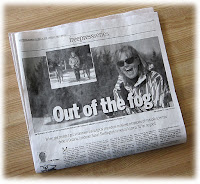The video of the teen wearing the red Make America Great Again (MAGA) hat in a face to face confrontation with a drum-pounding Native American went viral on social media.
Having spent more than four decade in the media, I am not surprised that newspaper journalists and television news reporters quickly cobbled together a narrative for publication and for broadcast.
Sadly, but not expectedly, the story as first reported may have been wrong. One reason for the errors may be found in the way journalist complete for stories and for attention. For years I have contended that journalists should cooperate rather than compete. To a certain extent this position has been validated by the recent ICIJ stories, the International Consortium of Investigative Journalists. If the hundreds of journalists working on this story had worked together, a far more accurate story could have been written and quickly as well.
For instance: it would have been clear that the Native American gentleman approached the teens and not the other way around as originally reported by many media outlets. Also, someone would have done the simple math and questioned the claim that the drummer was a Vietnam vet. It took days before this fact made it into the Washington Post.
I've also believed that stories should not be rushed into print. Stories should be done with accuracy in mind, not speed. All too often journalists make assumptions. Assumptions are quick. But, assumptions are also often wrong. A quivering BS detector can become a stand-in for facts.
Personally, I think there is a good story here. But, sorting it out will take a bit of time. In my humble opinion, journalists must not add to the confusion. I want to look to journalists for truth and not for conjecture.
The chap featured below, was the inspiration for this post. I do hope everyone understands I am treating him as the voice of journalism. After all, he was the chair of one of the most respected journalism departments in the province. His position, his actions, are the one's often followed by the industry today.
 |
| Journalists can rely too heavily on their BS detectors. |
The other day I saw the above tweet in my Twitter feed. It was posted by Paul Knox, a retired journalism professor from Ryerson in Toronto. Knox had tweeted that his BS detector was left quivering by the response of the teenage boy featured in the viral video of a standoff between the boy and a Native American gentleman.
I tweeted a reply. I didn't mean to upset Knox. I simply wanted to tell him that, after looking at the time stamp on his post, I was surprised a journalism professor was still pumping out the all-too-quickly reported original take on the incident. Many news outlets were retracting their original stories. The story as it was unfolding was becoming more and more complex.
Knox got his knickers in a knot. He took great offence at being accused of "pumping out" a premature take on the incident. He responded by pumping out a number of rapid-fire, defensive tweets.
Knox put me in my place, telling me I was wrong to think he had any preconceived opinions. He didn't. But, "as for more questions, yes, I have them," he tweeted. He continued, "If I were a reporter chasing the story I’d ask them. I’m not. I’m retired and on Twitter." And putting his much BS-Detector to good use, I might add.
I told Knox, "I feel very strongly about journalism. It's an incredibly important job. But, since retiring, I've learned Edward R. Murrow was right: journalists have thin skins. Journalists are quick with fast quibs but slow with meaningful responses. I added, Twitter is not the best venue." I wasn't just thinking of Knox here but all the journalists reporting this story. I wondered if the chap with drum was really a Vietnam vet but I didn't contact any reporters with my question. I've tried that in the past and it lead nowhere good.
Knox didn't appreciate my reference to Edward R. Murrow and a famous remark of his. He took my remark very personally. In retrospect, I'm not surprised. At one point, Knox told me, "Please don’t lecture me about journalism. I spent years and years dealing with these issues. The best journalists are skeptics [
sic] as hell. But counter-narratives emerge all the time, on many different kinds of stories. People finally speak up. Another video surfaces ..."
Knox sure knows how to bring out the snorting, charging bull in me. Counter-narratives are one of my personal red flags. Get the story right the first time. And be damn careful with the counter-narratives.
A journalist must do the job properly the first time, make the background calls and check all the facts. And tread lightly when it comes to counter-narratives. These put my own BS-detector a quivering.
Think of the famous 60 Minutes Benghazi Report. The show, based on a counter-narrative, had one flaw: the counter-narrative was wrong.
According to the
Poynter Institute:
. . . “60 Minutes” aired a report that called into question the official version of what happened when the U.S. diplomatic compound was attacked in Benghazi, Libya. At the core of the story was a source, Dylan Davies, who worked as a security contractor for the State Department. Davies had a book coming out that purported to share new facts about what happened that night, and what he did.
Problem one: he lied to the show about what he did and saw, thereby making a core piece of evidence in the “60 Minutes” counter-narrative false and undercutting the entire segment.
Problem two: it only took days for other news outlets, such as The Washington Post and The New York Times, to reveal significant flaws with the story, and with Davies. . . . "
I bow to the professor. He is, of course, right when he talks about journalism. He's been a guiding force in the industry for years. I'm sure his positions, when it comes to journalism, are completely defensible. It is how things are done. But, my contention is that folk, like the good professor, should be confronted. The old rules have let us down time and time again. It is time for a new playbook.
The old BS-detector has let us down too many times. Need proof? Read:
Who's a photojournalist?
The New York Times couldn't recognize a staged photo!
Or think of the infamous UFFI story. Thousands of people's lives were severely impacted by that bit of shoddy journalism. Retirees who had put their faith in their home as their retirement nest-egg saw it shrivel because a lot of journalists wanted to be first with the story. The counter-narrative, although true, never got traction.
 |
| The counter-narrative never got traction. I still see the UFFI myth treated as truth by the media. |

Or how about another famous BS-Detector failure: Liberation Therapy?
People, people full of hope, died having this procedure preformed out-of-country. My heart doctors were not fooled but journalists were. Today, even the doctor behind the theory admits it does not work.
I believe journalists need more than a BS-Detector. Journalists need time and facts and money.
__________________________________
It is looking as if we can add the Covington students to our list of infamous BS-detector generated stories.
- Nathan Phillips approached the students not the other way around.
- Nathan Phillips did not serve in Vietnam. He is not a Vietnam War vet.
- Most students bought their MAGA hat for the March of Life.
- In years past, students bought Obama-era "Hope" hats while visiting Washington, D.C.
- Nathan Phillips attempted to disrupt Mass at DC’s National Shrine



















